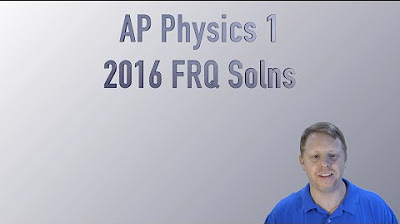AP Physics - Atwood Machines
TLDRIn this informative video, Dan Fullerton introduces the concept of Atwood machines, which are essential for understanding the constant tension in a light string passing over a massless pulley. The video's primary objectives are to help students analyze the motion of a two-object system connected by a string and to solve problems involving Newton's laws that result in simultaneous linear equations. By using clear examples and step-by-step explanations, Fullerton demonstrates how to set up and solve these problems, ultimately enhancing the viewer's comprehension of these fundamental physics concepts.
Takeaways
- 📚 The Atwood machine is a lab apparatus consisting of two masses, m1 and m2, connected by a string over a massless, frictionless pulley.
- 🎯 The key concept is that the tension in the string is constant, allowing for the analysis of the motion of the system of two objects.
- 📈 Newton's second law is applied to solve problems involving the system, leading to simultaneous linear equations with unknown forces or accelerations.
- 🔄 The setup assumes ideal conditions: massless string, no friction, and no inertia from the pulleys.
- 🧭 A positive direction must be chosen to analyze the motion, with one object moving up (positive) and the other down (negative).
- 📊 Freebody diagrams are used to analyze each mass separately, applying Newton's second law to determine the forces acting on each.
- 🔧 The tension in the string can be expressed in terms of the masses' accelerations and gravitational forces, leading to an equation for the system.
- 🌐 Two methods are presented for solving the system: analyzing each mass individually or considering the system as a whole.
- 📝 The acceleration of the system can be calculated using the formula: a = (G * (m1 - m2)) / (m1 + m2), where G is the acceleration due to gravity.
- 📚 The Atwood machine is relevant to AP Physics B and C objectives, providing a context for understanding and applying fundamental physics concepts.
- 💡 The video encourages further exploration of Atwood machines and related physics topics through additional resources like 'a plus physics comm'.
Q & A
What is the primary purpose of discussing Atwood machines in the context of this lesson?
-The primary purpose is to introduce students to the concept that tension is constant in a light string passing over a massless pulley, and to use this fact to analyze the motion of a system of two objects joined by a string.
What are the key objectives of this lesson on Atwood machines?
-The key objectives are to analyze the motion of a system of two objects joined by a string and to solve problems where applications of Newton's laws lead to simultaneous linear equations involving unknown forces or accelerations.
What is an Atwood machine?
-An Atwood machine is a lab apparatus or experimental setup where two objects of mass m1 and m2 are connected by a light, massless string to an ideal, massless pulley.
What assumptions are made in the properties of an Atwood machine?
-The assumptions include that the pulleys are ideal, meaning they are frictionless, massless, and have no inertia added to the system. Additionally, the tension in the light string over the ideal pulley is constant.
How does one set up a problem involving an Atwood machine?
-To set up such a problem, the first step is to decide on a direction to call positive. Then, analyze each mass separately using Newton's second law and freebody diagrams.
How does the speaker suggest choosing a positive direction in an Atwood machine problem?
-The speaker suggests choosing a consistent direction and calling it the positive direction, typically based on the observed motion of the objects, with one object moving up and the other moving down.
What is the first Newton's second law equation written in the script, and for which mass was it written?
-The first Newton's second law equation written in the script is for mass m2, and it is T - m2g = m2a, where T is the tension, m2 is the mass of the second object, g is the acceleration due to gravity, and a is the acceleration.
How is the tension in the string related to the acceleration of the system?
-The tension in the string is equal to the mass of the second object times its acceleration plus the mass of the second object times the acceleration due to gravity.
What is the second Newton's second law equation written in the script, and for which mass was it written?
-The second Newton's second law equation written in the script is for mass m1, and it is m1g - T = m1a, where m1 is the mass of the first object, g is the acceleration due to gravity, T is the tension, and a is the acceleration.
How can the acceleration of the system be found by analyzing the system as a whole?
-By analyzing the system as a whole and applying Newton's second law, the acceleration can be found using the equation G(m1 - m2) = (m1 + m2)a, where G is the acceleration due to gravity, m1 and m2 are the masses of the objects, and a is the acceleration of the system.
What is an alternate method to solve for the system's acceleration mentioned in the script?
-An alternate method mentioned in the script is to analyze the entire system as a closed system and apply Newton's second law directly, which leads to the same equation for the system's acceleration: a = G(m1 - m2) / (m1 + m2).
Outlines
📚 Introduction to Atwood Machines and Problem Setup
This paragraph introduces the concept of Atwood machines, which are experimental setups used to demonstrate the constant tension in a light string passing over a massless pulley. The main objective is to use this principle to analyze the motion of a system with two objects connected by a string. The video aims to help students understand how to solve problems involving Newton's laws that result in simultaneous linear equations with unknown forces or accelerations, aligning with AP Physics B and C objectives. The setup involves two objects of masses m1 and m2 connected by a string, with the assumption that the pulley is ideal (frictionless and massless), leading to constant tension throughout the string.
🔍 Analyzing the System and Newton's Second Law
In this paragraph, the speaker explains how to set up and analyze problems involving Atwood machines using Newton's second law. The process begins by defining a positive direction for the analysis. The speaker chooses the direction where one object moves up and the other down as the positive direction. Using Freebody diagrams and Newton's second law, the speaker analyzes each mass separately to write equations for the net force acting on each mass. The equations are then solved to find the acceleration of the system. An alternative method is also discussed, where the entire system is considered as a closed system, and Newton's second law is applied to find the overall acceleration. The speaker emphasizes that both methods yield the same result, providing a comprehensive understanding of how to approach Atwood machine problems.
Mindmap
Keywords
💡Atwood Machine
💡Tension
💡Newton's Laws
💡Freebody Diagram
💡Acceleration
💡Mass
💡Pulley
💡Linear Equations
💡Positive Direction
💡Frictionless
💡Gravitational Acceleration (g)
Highlights
Introduction to Atwood machines and their educational purpose.
Tension is constant in a light string passing over a massless pulley.
Using the constant tension to analyze the motion of a system of two objects joined by a string.
Solving problems involving Newton's laws that lead to simultaneous linear equations.
Atwood machine as a lab apparatus with two objects of mass m1 and m2 connected by a string.
Properties of an Atwood machine: ideal, frictionless, and massless pulleys.
Setting a positive direction for problem-solving consistency.
Analyzing each mass separately using Newton's second law and Freebody diagrams.
Writing Newton's second law equations for each mass in the Y direction.
Solving for tension in the system using Newton's second law equations.
Rearranging the equations to solve for the system's acceleration.
Alternate method of solving by analyzing the system as a whole.
Newton's second law applied to the entire system for a different perspective.
Deriving the same result for acceleration using the alternate method.
Atwood machines' relevance to AP Physics B and AP Physics C objectives.
The importance of understanding Atwood machines for academic and practical applications.
Resource recommendation for further help and information on Atwood machines.
Transcripts
5.0 / 5 (0 votes)
Thanks for rating:





